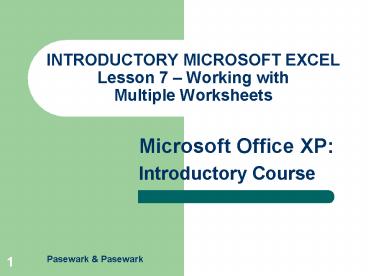INTRODUCTORY MICROSOFT EXCEL Lesson 7 Working with Multiple Worksheets - PowerPoint PPT Presentation
1 / 12
Title:
INTRODUCTORY MICROSOFT EXCEL Lesson 7 Working with Multiple Worksheets
Description:
Change the position of a worksheet. Insert and delete worksheets in a workbook. ... The default name of worksheets are Sheet1, Sheet2, and so on. ... – PowerPoint PPT presentation
Number of Views:235
Avg rating:3.0/5.0
Title: INTRODUCTORY MICROSOFT EXCEL Lesson 7 Working with Multiple Worksheets
1
INTRODUCTORY MICROSOFT EXCELLesson 7 Working
with Multiple Worksheets
2
Objectives
- Name worksheets in a workbook.
- Color worksheet tabs.
- Change the position of a worksheet.
- Insert and delete worksheets in a workbook.
- Link data between worksheets.
- Create three-dimensional references.
- Print workbooks and portions of workbooks.
3
Terms Used in This Lesson
- Active sheet
- Link
- Sheet tabs
- Three-dimensional cell reference
- Workbook
4
Name Worksheets in a Workbook
- Worksheets are identified by naming them and by
the tab color. - The default name of worksheets are Sheet1,
Sheet2, and so on. - To change the name, double-click the sheet tab,
and then key a new name.
5
Color Worksheet Tabs
- To change the tab color of the active sheet
- Choose Sheet from the Format menu.
- Choose Tab Color from the submenu.
- When the Format Tab Color dialog box appears,
click the color that you want to appear on the
tab.
6
Change the Position of a Worksheet
- Worksheets may be added to or deleted from a
workbook. - The position of a worksheet may be changed by
dragging the tab at the bottom of the workbook
window.
7
Link Data Between Worksheets
- Link - transfers data from one worksheet to
another. - To use data from one worksheet in another
worksheet of a workbook - Select the destination cell and then enter an .
- Click the sheet tab that contains the source data
you would like to link. - Select the cell or range of cells.
- Press Enter.
8
Create Three-Dimensional References
- Three-dimensional references are formula
references that incorporate data from worksheets
in an active worksheet. - Example the formula
- SUM(Sheet2Sheet4!D12)
- Adds the values in D12 on Sheet2, Sheet3, and
Sheet4.
9
Print Workbooks and Portions of Workbooks
- You may print
- An entire workbook.
- Selected worksheets.
- Selected areas of a workbook.
10
Summary
- Worksheets are identified by naming and by
changing the color of the worksheet tabs. - Worksheets in a workbook may be inserted in and
deleted from the workbook. - The position of a worksheet may be changed by
dragging the worksheet tab.
11
Summary
- Data in one worksheet may be linked to another
worksheet. - Three-dimensional references permit data from
multiple worksheets to be used in formulas. - Entire workbooks, selected worksheets, or
selected areas of a workbook may be printed.
12
- Return to the beginning of this presentation.
- Return to the PowerPoint Index































